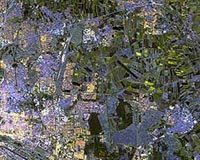 |
Pasadena CA (SPX) Oct 02, 2009 NASA and Argentina's Comision Nacional de Actividades Espaciales (CONAE), with support from the Argentine Ministry of Science, Technology and Innovative Production (MinCyT), have selected additional members of the international scientific investigating team for the Aquarius/Satelite de Aplicaciones Cient´┐Żficas (SAC)-D mission, scheduled to launch in 2010. The new team members include two from NASA's Jet Propulsion Laboratory, Pasadena, Calif. The joint minimum three-year mission will carry a suite of instruments into space onboard the Argentine-built SAC-D spacecraft. NASA's sensor, Aquarius, is the primary instrument on the mission. Aquarius is designed to provide monthly global maps of how salt concentration varies on the ocean surface - a key indicator of ocean circulation and its role in climate change. Seven CONAE-sponsored instruments will provide environmental data for a wide range of applications, including natural hazards, land processes, epidemiological studies and air quality issues. NASA and CONAE conducted a joint solicitation and selection of scientific investigations and innovative application demonstration projects using Aquarius/SAC-D observations. NASA selected 15 projects that it will fund over the next four years for a total of $8 million. CONAE/MinCyT selected 15 Argentine projects with participation of scientists from Chile and Brazil, which will be funded for a total of $1.3 million. An additional 10 proposals were selected from scientists in Italy and Japan. The primary focus of the selected projects is to prepare the scientific community to use Aquarius/SAC-D observations to better understand the interactions between global ocean circulation, the water cycle and Earth's climate. Several projects will concentrate on socio-economic applications of the mission's observations in such areas as fishery management, disease and flood forecasting, and monitoring volcanic eruptions and fires. The principal investigators for the NASA-funded projects are: + William Asher, University of Washington, Seattle + Frederick Bingham, University of North Carolina, Wilmington + Shannon Brown, NASA's Jet Propulsion Laboratory, Pasadena, Calif. + Antonio Busalacchi, University of Maryland, College Park + Ichiro Fukumori, Jet Propulsion Laboratory, Pasadena, Calif. + Arnold Gordon, Lamont-Doherty Earth Observatory, Columbia University, Palisades, N.Y. + Thomas Jackson, U. S. Department of Agriculture, Beltsville, Md. + W. Linwood Jones, University of Central Florida, Orlando + Roger Lang, George Washington University, Washington, D.C. + William Large, National Center for Atmospheric Research, Boulder, Colo. + Nikolai Maximenko, University of Hawaii, Honolulu + Rui Ponte, Atmospheric and Environmental Research, Inc., Cambridge, Mass. + Stephen Riser, University of Washington, Seattle + Douglas Vandemark, University of New Hampshire, Durham + Frank Wentz, Remote Sensing Systems, Santa Rosa, Calif. The principal investigators for the CONAE/MinCyT-funded projects are: + Miguel Bertolami, National University of the Patagonia San Juan Bosco, Chubut, Argentina + Marcelo Cassini, National University of Luj´┐Żn, Buenos Aires, Argentina + Carlos Cotlier, National University of Rosario, Santa Fe, Argentina + Dora Goniadzki, National Water Institute, Buenos Aires, Argentina + Ra´┐Żl Guerrero, National Institute for Fisheries Research and Development, Buenos Aires, Argentina + Haydee Karszenbaum, University of Buenos Aires, Buenos Aires, Argentina + Maite Narvarte, Marine Biology Institute Alte. Storni, Chubut, Argentina + Alberto Piola, Naval Hydrographic Service, Buenos Aires, Argentina + Gloria Pujol, National Meteorological Service, Buenos Aires, Argentina + Mirta Raed, National University of Luj´┐Żn, Buenos Aires, Argentina + Ra´┐Żl Rivas, National University of Centro, Buenos Aires, Argentina + Cristina Rodriguez, Mariscope Chilena Department of Oceanography, Puerto Montt, Chile + Hector Salgado, Naval Hydrographic Service, Buenos Aires, Argentina + Paola Salio, National University of Buenos Aires, Buenos Aires, Argentina + Cristina Serafini, National University of Luj´┐Żn, Buenos Aires, Argentina NASA is providing the Aquarius instrument (which was built by JPL), along with launch services and Aquarius science data processing. JPL manages the Aquarius mission for NASA. NASA's Goddard Space Flight Center, Greenbelt, Md., is providing the Aquarius instrument radiometer. CONAE is providing the SAC-D spacecraft; additional instruments, including optical and thermal cameras, a microwave radiometer and other specific sensors (with participation from Italy, France, Canada and various Argentine institutions); and mission operations. Launch of Aquarius/SAC-D onboard a Delta II rocket is scheduled for no earlier than May 2010 from Vandenberg Air Force Base in California. Share This Article With Planet Earth
Related Links Aquarius/SAC-D mission Earth Observation News - Suppiliers, Technology and Application
 TerraSAR-X Image Of The Month: Munich And Its Environs
TerraSAR-X Image Of The Month: Munich And Its EnvironsBonn, Germany (SPX) Sep 23, 2009 This image, from the German radar satellite TerraSAR-X, shows the urban region of Munich and the surrounding area. It was acquired on 2 May 2009 at a resolution of 10 metres. The colours in this radar image provide information about how strongly the surface of the Earth reflected back the transmitted radar signals in different polarisations. The urban area is depicted in shades of red and ... read more |
|
| The content herein, unless otherwise known to be public domain, are Copyright 1995-2009 - SpaceDaily. AFP and UPI Wire Stories are copyright Agence France-Presse and United Press International. ESA Portal Reports are copyright European Space Agency. All NASA sourced material is public domain. Additional copyrights may apply in whole or part to other bona fide parties. Advertising does not imply endorsement,agreement or approval of any opinions, statements or information provided by SpaceDaily on any Web page published or hosted by SpaceDaily. Privacy Statement |